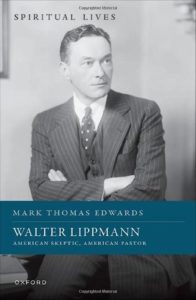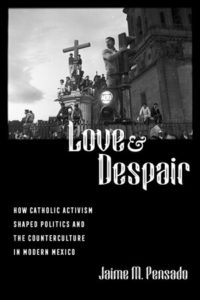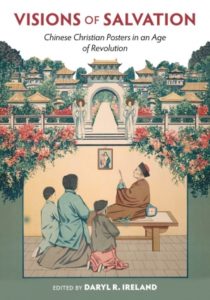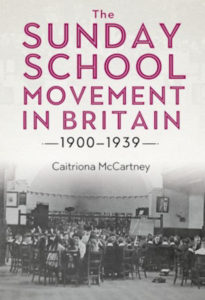Monthly Updates on Recent Books in the History of Christianity
To raise awareness of recent books in the history of Christianity, the editorial staff of Church History: Studies in Christianity and Culture highlights each month a list of 10-15 books in diverse periods and geographical regions that we hope will be of interest to our members. We include here below the 35th monthly list, chosen by our staff, with excerpts from the publishers’ blurbs.

Tiffany Beechy, Aesthetics and the Incarnation in Early Medieval Britain: Materiality and the Flesh of the Word. 2023
University of Notre Dame Press
Drawing on a wide range of critical methodologies, Aesthetics and the Incarnation in Early Medieval Britain treats this era as a “contact zone” of cultural clash and exchange, where Christianity encountered a rich amalgam of practices and attitudes, particularly regarding the sensible realm. Tiffany Beechy illustrates how local cultures, including the Irish learned tradition, received the “Word that was made flesh,” the central figure of Christian doctrine, in distinctive ways: the Word, for example, was verbal, related to words and signs, and was not at all ineffable. Likewise, the Word was often poetic—an enigma—and its powerful presence was not only hinted at (as St. Augustine would have it) but manifest in the mouth or on the page. Beechy examines how these Insular traditions received and expressed a distinctly iterable Incarnation. Often disavowed and condemned by orthodox authorities, this was in large part an implicit theology, expressed or embodied in form (such as art, compilation, or metaphor) rather than in treatises. Beechy demonstrates how these forms drew on various authorities especially important to Britain—Bede, Gregory the Great, and Isidore most prominent among them.
Beechy’s study provides a prehistory in the English literary tradition for the better-known experimental poetics of Middle English devotion. The book is unusual in the diversity of its primary material, which includes visual art, including the Book of Kells; obscure and often cursorily treated texts such as Adamnán’s De locis sanctis (“On the holy lands”); and the difficult esoterica of the wisdom tradition

Norman E. Donoghue II, Prisoners of Congress: Philadelphia’s Quakers in Exile, 1777-1778. 2023
Pennsylvania State University Press
In 1777, Congress labeled Quakers who would not take up arms in support of the War of Independence as “the most Dangerous Enemies America knows” and ordered Pennsylvania and Delaware to apprehend them. In response, Keystone State officials sent twenty men—seventeen of whom were Quakers—into exile, banishing them to Virginia, where they were held for a year.
Prisoners of Congress reconstructs this moment in American history through the experiences of four families: the Drinkers, the Fishers, the Pembertons, and the Gilpins. Identifying them as the new nation’s first political prisoners, Norman E. Donoghue II relates how the Quakers, once the preeminent power in Pennsylvania and an integral constituency of the colonies and early republic, came to be reviled by patriots who saw refusal to fight the English as borderline sedition.
Surprising, vital, and vividly told, this narrative of political and literal warfare waged by the United States against a pacifist religious group during the Revolutionary War era sheds new light on an essential aspect of American history. It will appeal to anyone interested in learning more about the nation’s founding.

Mark Thomas Edwards, Walter Lippmann: American Skeptic, American Pastor. 2023
Walter Lippmann was arguably the most recognized and respected political journalist of the twentieth century. His "Today and Tomorrow" columns attracted a global readership of well over ten million. Lippmann was the author of numerous books, including the best-selling A Preface to Morals (1929) and U.S. Foreign Policy (1943). His Public Opinion (1922) remains a classic text within American political philosophy and media studies. Lippmann coined or popularized several keywords of the twentieth century, including "stereotype," the "Cold War," and the "Great Society." Sought out by U.S. Presidents and by America's allies and rivals around the world, Lippmann remained one of liberalism's most faithful proponents and harshest critics.
Yet few people then or since encountered the "real" Walter Lippmann. That was because he kept crucial parts of himself hiding in plain sight. His extensive commentary on politics and diplomacy was bounded by his sense that America had to adjust to the loss of a common faith and morality in a "post-Christian" era. Over the course of his life, Lippmann traded in his fame as a happy secularist for the stardom of a grumpy Western Christian intellectual. Yet he never committed himself to any religious system, especially his own Jewish heritage.
Walter Lippmann: American Skeptic, American Pastor considers the role of religions in Lippmann's life and thought, prioritizing his affirmation and rejection of Christian nationalisms of the left and right. It also yields fresh insights into the philosophical origins of modern American liberalism, including liberalism's blind spots in the areas of sex, race, and class. But most importantly, this biography highlights the constructive power of doubt. For Lippmann, the good life in the good society was lived in irreconcilable tension: the struggle to be free from yet loyal to a way of life; to recognize the dangers yet also necessity of a civil religion; and to strive for a just and enduring world order that can never be. In the end, Lippmann manufactured himself as the prophet of limitation for an extravagant American Century.

Jaime M. Pensado, Love and Despair: How Catholic Activism Shaped Politics and the Counterculture in Modern Mexico. 2023
University of California Press
Love and Despair explores the multiple and mostly unknown ways progressive and conservative Catholic actors, such as priests, lay activists, journalists, intellectuals, and filmmakers, responded to the significant social and cultural shifts that formed competing notions of modernity in Cold War Mexico. Jaime M. Pensado demonstrates how the Catholic Church as a heterogeneous institution—with key transnational networks in Latin America and Western Europe—was invested in youth activism, state repression, and the counterculture from the postwar period to the more radical Sixties. Similar to their secular counterparts, progressive Catholics often saw themselves as revolutionary actors and nearly always framed their activism as an act of love. When their movements were repressed and their ideas were co-opted, marginalized, and commercialized at the end of the Sixties, the liberating hope of love often turned into a sense of despair.

Daryl R. Ireland, ed. Visions of Salvation: Chinese Christian Posters in an Age of Revolution. 2023
Between the May Fourth Movement of 1919 and the Communist Revolution of 1949, Chinese Christians had to compete with Nationalist and Communist ideologies over how best to save the nation. They, along with China’s political parties, adopted propaganda posters and relied on their eye-catching colors and potent symbolism to win the hearts of the masses. Because these images were meant to attract the public, we can look at the posters and ask, What did Christian artists and evangelists believe would appeal to viewers? How did they choose to present the gospel to a Chinese audience?
The answers may come as a surprise, as Jesus is scarcely present. Instead, playful children, the Chinese flag, lotus flowers, clean teeth, and other images became the vehicles Christians used to address the felt needs and aspirations of a nation struggling to survive. Unpacking the significance of these and other visual cues, Visions of Salvation offers a fresh look at Chinese history and theology.
Drawing on a landmark collection of more than 200 color prints, assembled and analyzed here for the first time, leading scholars in Chinese Studies, mission history, Chinese Christianity, and visual culture reassess various facets of Chinese life in the second quarter of the twentieth century. In an age of revolution, political activists were not the only ones advancing prescriptions for change. Chinese Christians also pursued a New China, as one poster explicitly put it. Though later suppressed and largely forgotten, Christian posters placarded the country for thirty years with an alternative vision of national salvation.

Hilaire Kallendorf, A Companion to the Queenship of Isabel la Católica. 2022
The queenship of the first European Renaissance queen regnant never ceases to fascinate. Was she a saint or a bigoted zealot? A pious wife or the one wearing the pants? Was she ultimately responsible for genocide? A case has been made to canonize her. Does she deserve to be called Saint Isabel? As different groups from fascists to feminists continue to fight over Isabel as cultural capital, we ask which (if any) of these recyclings are legitimate or appropriate. Or has this figure taken on a life of her own?

Joseph F. Byrnes, God on the Western Front: Soldiers and Religion in World War I. 2023
From 1914 to 1918, religious believers and hopeful skeptics tried to find meaning and purpose behind divinely willed destruction. God on the Western Front is a history of lived religion across national boundaries, religious affiliations, and class during World War I, utilizing an expansive record of primary sources.
Joseph F. Byrnes takes readers on a tour of the battlefields of France, listening to the words of German, French, and English soldiers; going behind the lines to hear from the men and women who provided pastoral and medical care; and reviewing the religious writings of priests, bishops, ministers, and rabbis as they tried to make sense of it all. The story begins with citizens at home as they responded to the obligation to make war and then focuses on the “God-talk” and “nation-talk” that soldiers used to express their foundational religious experiences. Byrnes’s study attends to the words of average men who struggled to articulate their religious sentiments, alongside the generals Helmuth von Moltke, Ferdinand Foch, and Douglas Haig and the soldier theologians Franz Rosenzweig, Paul Tillich, Pierre Teilhard de Chardin, and Geoffrey Studdert Kennedy. In doing so, he shows how religious and battle experience are intertwined and showcases the wide range of spiritual responses that emerged across boundaries.
Going beyond the typical constraints of studies focused either on one nation or one confessional affiliation, Byrnes’s international and interfaith approach breaks new ground. It will appeal to scholars and students of modern European history, religious history, and the history of war.

Volker L. Menze, Patriarch Dioscorus of Alexandria: The Last Pharaoh and Ecclesiastical Politics in the Later Roman Empire. 2023
Patriarch Dioscorus of Alexandria: The Last Pharaoh of Alexandria and Ecclesiastical Politics in the Later Roman Empire offers a thorough revision of the historical role of Dioscorus as patriarch of Alexandria between 444 and 451 CE. The monograph works on the premise that the Christological controversy of the fifth century can only be fully understood against the background of imperial politics in the Later Roman Empire. Christian theology did not develop without its historical context, and how ‘Orthodoxy’ was implemented depended on the mechanisms of late imperial (ecclesiastical) politics. The focus is on Dioscorus, one of the major protagonists of the Christological controversy, whose image is extremely distorted: he became a saint in those eastern church traditions which oppose the Council of Chalcedon, while western church traditions remember him as heretic and violent villain. Western scholarship maintains the image of Dioscorus as ‘ruthless and ambitious’, a ‘tyrant-bishop’ feared by his opponents—the ‘Attila of the Eastern Church’. The book breaks with these negative stereotypes and offers the first serious historical analysis of Dioscorus as ecclesiastical politician and reformer. It discusses the discrepancy that theologically Dioscorus was a loyal follower of his famous predecessor Cyril of Alexandria (412–444) while politically he was the protagonist of the anti-Cyrillian party in Alexandria. Analysing Dioscorus’ role as president of the Second Council of Ephesus in 449 and his downfall and deposition at the Council of Chalcedon in 451, the book also offers a much-needed new reading of the acts of these two general councils.

Donald Sinnema, Christian Moser, Erik A. de Boer, and Herman J. Selderhuis, eds. The Convening of the Synod of Dordt. 2023
Vandenhoeck & Ruprecht Verlage
The Synod of Dordt 1618/1619 was one of the most important church councils in the history of the Reformed tradition. International delegates from all over Europe served as important participants and played a significant role in the evaluation of Remonstrant doctrine and in the formation of the Canons of Dordt. The Synod made important pronouncements on other issues such as Sunday observance, catechism instruction and theological education. Given the continuing worldwide historical significance of the Synod’s Canons and church order, the absence of a critical scholarly edition of the majority of documents of the Synod is remarkable. The Johannes a Lasco Bibliothek in Emden, a leading research center for the history and theology of Reformed Protestantism, has taken the initiative to edit the Acts and documents of the Synod of Dordt.

Mary Cunningham, The Virgin Mary in Byzantium, c. 400-1000: Hymns, Homilies, and Hagiography. 2022
The Virgin Mary assumed a position of central importance in Byzantium. This major and authoritative study examines her portrayal in liturgical texts during the first six centuries of Byzantine history. Focusing on three main literary genres that celebrated this holy figure, it highlights the ways in which writers adapted their messages for different audiences. Mary is portrayed variously as defender of the imperial city, Constantinople, virginal Mother of God, and ascetic disciple of Christ. Preachers, hymnographers, and hagiographers used rhetoric to enhance Mary's powerful status in Eastern Christian society, depicting her as virgin and mother, warrior and ascetic, human and semi-divine being. Their paradoxical statements were based on the fundamental mystery that Mary embodied: she was the mother of Christ, the Word of God, who provided him with the human nature that he assumed in his incarnation.


Geoffrey Troughton, ed. Pacifying Missions: Christianity, Violence, and Empire in the Nineteenth Century. 2023
Pacifying Missions provides the first sustained examination of peace and missionary work in the context of the British Empire. It interrogates diverse missionary projects from Africa and the Pacific region, unfolding a variegated world of ideas, discourses, and actions. The volume yields compelling evidence for a reconsideration of peace as a vital focus for analysis in the history of Christian mission. It also reveals a landscape of peace that was plural, dynamic, and contested, worked out in specific contexts, and deeply entangled with understandings and experiences of violence.
Caitriona McCartney, The Sunday School Movement in Britain, 1900-1939. 2023
Sunday schools were an important part of the religious landscape of twentieth-century Britain and they were widely attended by much of the British population. The Sunday School Movement in Britain argues that the schools played a vital role in forming and sustaining the faith of those who lived and served during the First World War. Moreover, the volume contends that the conflict did not cause the schools to decline and proposes that decline instead set in much earlier in the twentieth century.
The book also questions the perception that the schools were ineffective tools of religious socialisation and examines the continued attempts of the Sunday school movement to professionalise and improve their efforts. Thus, the involvement of the movement with the World's Sunday School Association is revealed to be part of the wider developing international ecumenical community during the twentieth century.
Drawing together under-utilized material from archives and newspapers in national and local collections, The Sunday School Movement in Britain presents a history of the schools demonstrating their lasting significance in the religious life of the nation and, by extension, the enduring importance of Christianity in Britain during the first half of the twentieth century.
Finally, for staying up-to-date on the latest titles in all fields, we recommend regularly perusing New Books Network and its "New Books in Christian Studies” page. These pages are updated regularly.
